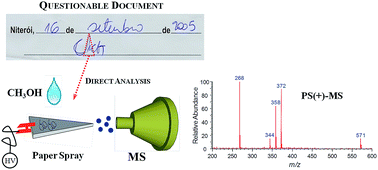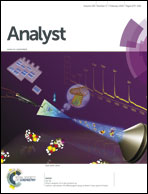Forensic analysis of ballpoint pen inks using paper spray mass spectrometry†
Abstract
A novel analytical approach based on paper spray mass spectrometry (PS-MS) is developed for a fast and effective forensic analysis of inks in documents. Ink writings made in ordinary paper with blue ballpoint pens were directly analyzed under ambient conditions without any prior sample preparation. Firstly, the method was explored on a set of distinct pens and the results obtained in the positive ion mode, PS(+)-MS, demonstrated that pens from different brands provide typical profiles. Simple visual inspection of the PS(+)-MS led to the distinction of four different combinations of dyes and additives in the inks. Further discrimination was performed by using the concept of relative ion intensity (RII), owing to the large variability of dyes BV3 and BB26 regarding their demethylated homologues. Following screening and differentiation studies, the composition changes of ink entries subjected to light exposure were also monitored by PS-MS. The results of these tests revealed distinct degradation behaviors which were reflected on the typical chemical profiles of the studied inks, attesting that PS-MS may be also useful to verify the fading of dyes thus allowing the discrimination of entries on a document. As proof of concept experiments, PS-MS was successfully utilized for the analysis of archived documents and characterization of overlapped ink lines made on simulated forged documents.


 Please wait while we load your content...
Please wait while we load your content...